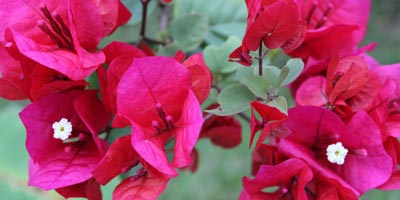
“Why are we pulling over?” I asked as I stared at the quiet forest of palm trees.
After I learned that my Costa Rica guide, Alex Monge, had spotted something, I hurried out of the motorcoach and scanned the trees for life. I started to think that the guide was mistaken when I heard an odd howling noise coming from above.
Soon the rustling of palm trees betrayed the location of a previously hidden family of howler monkeys gazing down at us. Though their unusual cries seemed to indicate their displeasure at our intrusion, they glided gracefully along the treetops using their tails as a fifth limb.
How had Alex spotted them? The dark brown and black colors effectively hid them from the passing cars.
As I traveled through Costa Rica with tour operator Trips, I learned that chance sighting was no fluke. Alex managed to spy a tree frog at night, the silhouette of a sloth hanging in a distant tree and numerous other incredible creatures I would have passed by unaware without his help.
During my week in Costa Rica, I not only enjoyed the tour’s luxurious hotels and screen-saver-worthy views, but I also realized the benefit of traveling with a professional guide each time I experienced another exciting wildlife encounter.
West Virginia With Monkeys
My first excursion took me up the steep mountains surrounding San Jose. I admired the picturesque fields of coffee, pineapple, sugar cane, mangoes and more when I wasn’t straining to spot wildlife.
“Costa Rica is only 35,000 square miles big, which is about the surface area of West Virginia,” Alex said. “We have 6 percent of the world’s biodiversity, which is amazing for such a small country. The wildlife from North America and South America merge here.”
Soon I arrived at the Poas Volcano National Park. A short walk past vibrant tropical flowers and trees in bloom led me to the mouth of the active volcano. The smell of sulfur reminded me that this was not just another vista but a powerful volcano. The fog billowing around the water-filled caldera created an atmosphere charged with mystery.
“This is one of the nation’s oldest and most visited national parks,” said Alex. “The volcano’s caldera is one mile across, which is one of the largest in the world.”
After leaving the 8,000-foot peak, I discovered the complicated process of making coffee at the Doka Coffee Plantation. The 180-acre farm produces premium coffee that continues to be handpicked by around 2,000 people.
“You will know enough to be coffee experts after this tour,” said Isaac, our guide of Doka Coffee Plantation. “Costa Rica only produces 3 percent of all coffee in the world. So to make a profit, our coffee has to be an expensive, high-quality coffee.”
I felt ready to grow my own coffee after learning which kinds of coffee berries were ripe, how to sort the bad berries from the quality berries with water and how to flip the dry beans every 30 minutes for five days. The plantation offered samples of various types of coffee to help me decide which ones to take home.
Next, I developed a better appreciation of detailed paintings at the Sarchi Artisan Center. The market displays elaborately painted oxcart wheels, a craft that remains popular in Costa Rica. I watched with interest as an on-site artist working meticulously on one large, colorful wheel.
After shopping for handmade crafts in the site’s store, I tried my own hand at oxcart wheel painting at the center’s art class. My thick strokes came nowhere close to the thin, detailed work shown in the example. My failed attempts made the surrounding crafts even more impressive.
I ended my day with a walk through a different kind of art at Zarcero’s city park. There, impressive bush sculptures create tunnels leading to a colorful church. Walking through the tunnel of green reveals more and more of the gorgeous church with every step.









